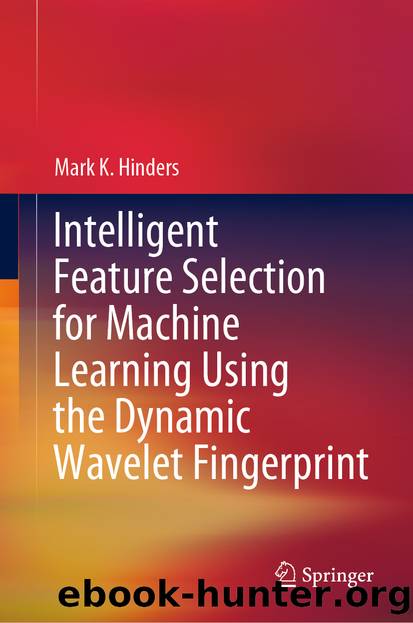Intelligent Feature Selection for Machine Learning Using the Dynamic Wavelet Fingerprint by Mark K. Hinders

Author:Mark K. Hinders
Language: eng
Format: epub
ISBN: 9783030493950
Publisher: Springer International Publishing
A few years ago these IR cameras started showing up as snap-on attachments to smartphones, e.g., FLIR One, which means that the cost of the technology is now low enough that it can be incorporated into residential security systems [9] and for some applications we actually do use dynamic wavelet fingerprints [10].
It’s well known that a variety of ghostly presences can be felt by the hauntee as a localized cold spot (Fig. 5.1), although rarely poltergeists and other hyperactive apparitions will manifest as a very subtle transient heat flash. Our security systems employ very sensitive infrared cameras to watch for anomalous hot or cold spots, and then track them using sophisticated computer processing of the imagery. Artificial Intelligence (AI)-based image processing is the second new technology that sets our system apart from all competitors. It turns out that having a human watch infrared imagery for ghostly hot and cold patterns doesn’t work. Ghosts are somehow able to modulate and morph their temperature signatures as they move in a way such that muggles will almost always miss it. In our many years of research and development, we have demonstrated scientifically that humans are only able to recognize such transients using peripheral vision. Our studies have also proven conclusively that no human can be expected to concentrate for extended periods using only their peripheral vision. We’ve had testees able to do it for 8 or 10 minutes at a stretch, but of course you never know when the haunting is going to happen. We have mimicked human peripheral vision in our AI computer system and then quite obviously make use of the computer’s ability to remain ever vigilant.
In our system, each room is outfitted with a small camera unit which can be built into either the ceiling or a light fixture. Only the 2 cm diameter hemispherical omni-directional fisheye lens actually needs to protrude into the room, and each lens has a full 360 field of view. One camera per room covers an entire house with no blind spots and no moving parts. Traditional cameras with their focused directional lenses either have to mechanically pan about the room or you have to have several cameras looking in different directions in order to get full coverage. Our computer image processors automatically undistort the images at up to several hundred frames per second, so that even the quickest of little beasties (ghosts, vermin, whatever) are captured without motion blurring.
Moreover, once an event is detected we pass those image files to a second AI module based on a dynamically adaptive artificial neural network (ANN) that uses wavelet fingerprints to classify the apparition into one of more than a hundred object classes according to their morphing, movements, etc. It then further categorizes the signals using machine learning techniques to identify the particular ghostly presence based on behavior patterns recorded in its database of past sightings. The system is also in continuous Internet contact with our central infrared imagery archival repository so that those ghosts who haunt more than one spatial and/or temporal locality can be tracked over both space and time.
Download
This site does not store any files on its server. We only index and link to content provided by other sites. Please contact the content providers to delete copyright contents if any and email us, we'll remove relevant links or contents immediately.
Algorithms of the Intelligent Web by Haralambos Marmanis;Dmitry Babenko(8519)
Test-Driven Development with Java by Alan Mellor(7353)
Data Augmentation with Python by Duc Haba(7252)
Principles of Data Fabric by Sonia Mezzetta(6996)
Learn Blender Simulations the Right Way by Stephen Pearson(6933)
Microservices with Spring Boot 3 and Spring Cloud by Magnus Larsson(6765)
RPA Solution Architect's Handbook by Sachin Sahgal(6168)
Hadoop in Practice by Alex Holmes(6028)
The Infinite Retina by Robert Scoble Irena Cronin(5870)
Jquery UI in Action : Master the concepts Of Jquery UI: A Step By Step Approach by ANMOL GOYAL(5869)
Big Data Analysis with Python by Ivan Marin(5693)
Life 3.0: Being Human in the Age of Artificial Intelligence by Tegmark Max(5398)
Pretrain Vision and Large Language Models in Python by Emily Webber(4654)
Infrastructure as Code for Beginners by Russ McKendrick(4438)
WordPress Plugin Development Cookbook by Yannick Lefebvre(4168)
Functional Programming in JavaScript by Mantyla Dan(4121)
The Age of Surveillance Capitalism by Shoshana Zuboff(4111)
Embracing Microservices Design by Ovais Mehboob Ahmed Khan Nabil Siddiqui and Timothy Oleson(3957)
Applied Machine Learning for Healthcare and Life Sciences Using AWS by Ujjwal Ratan(3930)
